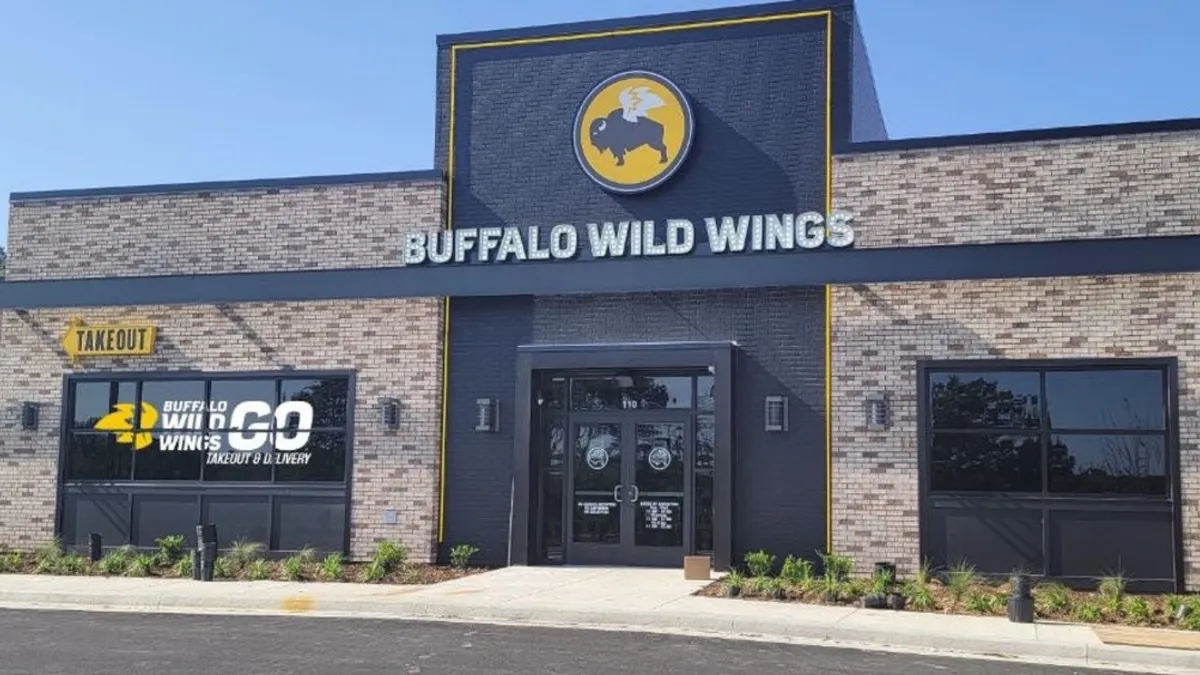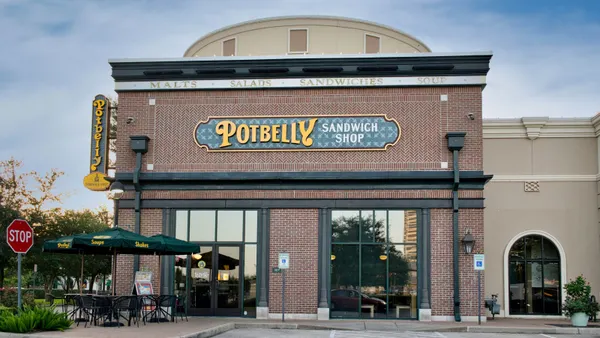Over 970,000 people traveled through Northwest Arkansas National Airport (XNA) last year. That means, Slim Chickens, which opened a restaurant inside the airport earlier this year, has nearly a million opportunities to boost brand awareness and service customers.
“Our brand is a really good option for airports because you can grab and go and it’s finger food,” said Jackie Lobdell, Slim Chickens VP of franchise development.
This is first of what the chain hopes will be many more U.S. airport locations. The company, which has 10 locations in Northwest Arkansas, has already seen high traffic and sales and Lobdell said it has been a “huge success.” XNA airport sits near the headquarters for Walmart, JB Hunt and Tyson.
“Letting new customers experience our brand and experience our food is number one for us,” Lobdell said.
Slim Chickens isn’t the only brand hoping to capture more travelers. Shake Shack, Chick-fil-A, Pizza Hut, KFC, McDonald’s and Starbucks also have a strong presence in airports. The global airport quick service restaurant market was valued at $174 billion in sales for 2023 and is expected to reach over $252 billion by 2033, according to Spherical Insights projections.
Other transit infrastructure offers opportunities too. Pollo Campero, a Guatemalan chicken chain with more than 400 global locations, plans to open a location in New York City’s Penn Station early next year, giving it access to one of the busiest rail hubs in North America. Pollo Campero takes a particular liking to building its flagship locations in locations heavily trafficked by tourists, according to Blas Escarcega, Pollo Campero’s vice president of franchise development.
But building sites in airports and other travel hubs, which are often dependent on seasonality, takes a lot of planning and consideration, from menus adjustments to revised strategies for labor and real estate.

What to know about airport locations
Even though consumers have recently become more price-sensitive, they are still spending money on airline travel, said Erik Herrmann, CapitalSpring partner and head of investment. Passenger air traffic in North America increased nearly 12% last year. Domestic traffic was up 9.5%, while international passenger traffic was up over 27% in 2023.
Airport locations serve a captive audience and offer an opportunity to charge higher prices than a traditional location, leading to higher margins. Being inside an airport can also help with brand building, Herrmann said.
“If you have a local brand, getting placement in an airport is a great way to introduce it to people from out of town and just build that brand equity,” Herrmann said.
At the same time, airport locations are complicated and the request for proposal process can get complex. Operators also may struggle to hire people who can pass more stringent security checks, such as an FBI fingerprint background check and TSA security threat assessment. Locations also need to be in places where there is consistent traffic since many purchases are impulse driven, and people aren’t likely to leave their terminal to seek out a specific brand.
“It’s really about flow and visibility,” Herrmann said. “With the right concept, with the right placement, with the right traffic flow in the airport, it can be really attractive.”
Brands like Slim Chickens are finding that flexibility pays off when establishing airport locations.
“We are super nimble, eager to adjust to the space at hand that works to our advantage because there are brands that will not bend and mold to whatever that airport needs,” Lobdell said.
The chain is looking to expand into more airports in Europe — it is already in Istanbul airport — as well as train stations, Lobdell said. But this is a long process, with airport locations taking a year or more to complete, she said.
“I’d like to see at least three more U.S. airport locations in the next five years,” Lobdell said.

Adjusting menus for on-the-go travelers
Concepts entering travel hubs also need to review their menu to see if they need to adjust, or add a daypart, like breakfast to ensure they are meeting the needs of the airport, Herrmann said.
Menus need to include grab-and-go items that provide speed and convenience, he said. Some full-service concepts work well in airports, but offering table service does add operational complexity.
At Northwest Arkansas National Airport, Slim Chickens needed to figure out if the space worked for the brand and how its menu would be modified. The chain typically adjusts its menu depending on the size of the cooler and other equipment and the efficiency of the back of house, she said. The chain can fit in spaces as small as 500 square feet.
A menu at a traditional Slim Chickens location includes tenders and wings, tender mac bowls, sandwiches and wraps, chicken and waffles, salads and desserts. Its Arkansas airport location lacks only the chicken and waffles category, she said.
“We’re very adept at paring down these menus for the space and for the demographic that we’re serving,” Lobdell said.

Why Pollo Campero likes tourist locations
Pollo Campero has found a niche in tourist locations. It has a site on San Francisco’s Fisherman’s Wharf and a couple of locations in New York City near the Port Authority Bus Terminal and Herald Square.
But these types of locations come with considerable risks. Tourist locations tend to be more volatile than travel-centric locations. While there could be a boom during the height of the season, operators need to ensure that they capture enough demand and revenue to carry them through the off-season, Herrmann said.
Brands should consider whether or not a site indexes above a typical site.
“Whether it’s non-traditional or traditional, I don’t think the analysis changes,” Hermann said. “What can be a little tricky on the non-traditional sites is when you have a seasonal kind of flow and population.”
Instead of looking at seasonal population, Hermann said operators should consider year-round residential population to better understand the market’s population and baseline demand to get a more precise picture of foot traffic in the area.
Pollo Campero has seasonality built into its models, said Blas Escarcega, Pollo Campero’s vice president of franchise development.
In Florida, where the brand has a dozen units, restaurants usually see higher customer volume in winter months, while locations in the north tend to do better in the summer months. That means adjusting its models for traffic count as well as its marketing initiatives for when customers are in its restaurants.
When traffic ebbs, the chain is able to maintain solid numbers, especially when it knows traffic will pick back up eventually, Escarcerga said.
“We try to optimize, as far as operating flagships, to make sure that we still maintain the customer experience [and are] properly staffed,” Escarcerga said. “We have those tweaks within our system that allows us to understand what to expect.”
Flagship locations are strictly company-owned and are used to build brand awareness. Those locations can help attract new franchisees, Escarcega said.
The layouts and sizes depend on the location, Escarcega said. Its Fisherman’s Wharf location has a more expansive layout than its locations in Manhattan, where buildings are smaller and older. Some flagships may even span more than one floor, such as its Herald Square location.
Regardless of size and design, Pollo Campero wants to ensure that these locations have the brand’s typical store design and technology features, like digital menu boards and kiosks. These locations may also sell merchandise like shirts and caps, Escarcega said.
“It sets a benchmark for our brand’s overall retail experience or restaurant experience,” he said.
Much like airports, Penn Station could provide a way for Pollo Campero to advertise to regional consumers who then would want to see the restaurants in their local communities.
The company says it will adjust the location to fit the space. Instead of a full dining room, the Penn Station restaurant may have a few single tables or a counter with seats, since people may need to sit for a few minutes to finish eating.
Figuring out what technology is needed is also key, he said. The Penn Station location will lean heavily on kiosk ordering, given peoples’ time constraints.
Pollo Campero expects to open 29 units this year and another 28 units next year in the U.S.
“There are definitely opportunities for us to build additional flagships,” Escarcerga said, adding that it evaluates locations on a case by case basis. “We’re going to be very careful that it makes sense for us and is strategic, but what we’ve done so far and what we will do going forward in the next 12 months will allow us to bring more of the brand awareness that we’re looking for in Pollo Campero.”


















